|
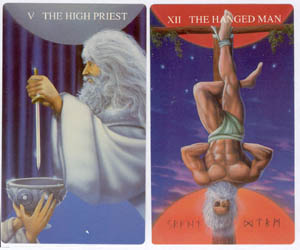 Let me begin with the beginning, the first impression. A yellow box. Outside a drawing depicting
a modern rendition of The Hermit. Above the drawing, the title "The Witches Tarot". Below two names:
Ellen Cannon Reed and Martin Cannon Reed. On the back of the box a text which states: "You have
never seen a Tarot Deck like this before!..." A promising statement or ....?
Let me begin with the beginning, the first impression. A yellow box. Outside a drawing depicting
a modern rendition of The Hermit. Above the drawing, the title "The Witches Tarot". Below two names:
Ellen Cannon Reed and Martin Cannon Reed. On the back of the box a text which states: "You have
never seen a Tarot Deck like this before!..." A promising statement or ....?
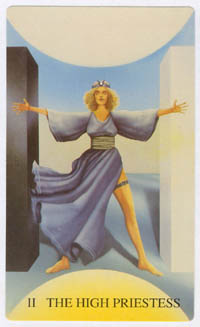
Well, let me open up to see this unique thing. What do I find? A piece of plastic foam, 78
colorful cards and a 27 page booklet the same size as the cards. Well no, not the same size, but
nearly. What is that slice of plastic foam for? Could it be necessary for performing a Witches
ritual? I remember, that Llewellyn has a box designer; he is probably responsible for this slice;
either the cards were too thin to fill up the box, or the box was too large for the cards (what's
the difference?) Our fanciful designer knows how to tackle such a situation; he cuts a slice of
foam to put into each of the - hopefully for Llewellyn- thousands of boxes. It does not completely
solve the problem, for now it shows, that it is not just the thickness that is wrong, also the area
of the card is too small, compared to the front of the box. Our box designer gives up. But what
the hell, nobody is perfect; and those Witches, they do not use the box anyway, they just use a
cloth to wrap the cards in.
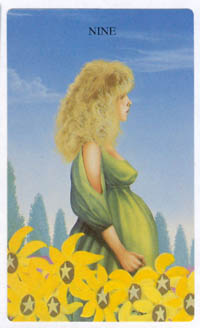 78 colorful cards we have here, painted by Martin Cannon in a style, that mostly reminds me of the
murals outside the cinemas in the 50's and 60's. 22 major arcana and four minor arcana series.
Most of the major arcana cards wear the traditional names, but The Hermit has changed to The Seeker
and The Devil to The Horned One. On The High Priestess card, we find the rune master from the cover
of Donald Tysons book on runes. A little later the rune master has been through a course in body
building, where he apparently lost his one eye, so he could act again as Odin, The Hanged Man.
Mr. Cannon apparently made his studies for this deck at the local health club, or at
weightlifting contests. On Eight of Pentacles he just had to exchange the weights with two books.
That was not even necessary with the Two of Pentacles. The female figures would also do well in
a Girlie-magazine. What associations the licking lion on the Strength can give! Those girls are
really so attractive, that not only The Empress got pregnant, but also the Three and Nine of Cups.
78 colorful cards we have here, painted by Martin Cannon in a style, that mostly reminds me of the
murals outside the cinemas in the 50's and 60's. 22 major arcana and four minor arcana series.
Most of the major arcana cards wear the traditional names, but The Hermit has changed to The Seeker
and The Devil to The Horned One. On The High Priestess card, we find the rune master from the cover
of Donald Tysons book on runes. A little later the rune master has been through a course in body
building, where he apparently lost his one eye, so he could act again as Odin, The Hanged Man.
Mr. Cannon apparently made his studies for this deck at the local health club, or at
weightlifting contests. On Eight of Pentacles he just had to exchange the weights with two books.
That was not even necessary with the Two of Pentacles. The female figures would also do well in
a Girlie-magazine. What associations the licking lion on the Strength can give! Those girls are
really so attractive, that not only The Empress got pregnant, but also the Three and Nine of Cups.
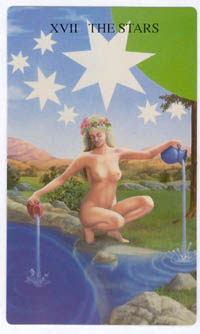 I wonder, if Mr. Cannon himself couldn't stand it any longer, when he reached the courts. Because,
actually the courts in all four suits are the same, just the coloring makes the difference. To
compensate for this, the booklet gives the advise, that if you deal a court card in a pattern,
the next card should go on top of that. In that way the likeness of the courts is not too obvious.
I wonder, if Mr. Cannon himself couldn't stand it any longer, when he reached the courts. Because,
actually the courts in all four suits are the same, just the coloring makes the difference. To
compensate for this, the booklet gives the advise, that if you deal a court card in a pattern,
the next card should go on top of that. In that way the likeness of the courts is not too obvious.
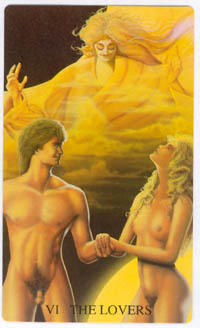 Whether this deck applies especially to Witches I do not know. I believe, that if I were a serious
student of the Craft, I would be rather offended to be presented with a thing like this.
Whether this deck applies especially to Witches I do not know. I believe, that if I were a serious
student of the Craft, I would be rather offended to be presented with a thing like this.
The accompanying booklet does not say very much, but a larger book is also available: "The
Witches Tarot" by Ellen Cannon Reed. In the 292 pages, the correspondence of this deck to the paths
of the kabbalistic Tree of Life and to Wicca is discussed. The characteristics of each of the
paths of The Tree are described, and their correspondences to letters, astrology, tarot, colors,
mythology, plants, perfumes and jewels are given. One could have feared, after having seen the
deck, that this text was likely to be superficial, but actually it is not. Tarot and Kabbalah,
and especially the connection between tarot and the paths, is a difficult subject and much of
the literature on this theme is difficult, if not impossible reading. Ellen Cannon Reed's text
is understandable, and she even softens the first impression of the deck by her explanation of it.
Let me say it in this way: You can not make do with the Witches Tarot without this book, but you
can make do with the book without the deck!
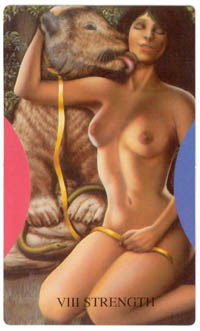
After the description of the paths the book goes on describing the cards. Here Ellen Cannon Reed
compares the pictures of the deck at hand with the Waite-Smith deck and the Golden Dawn Deck, and
also gives divinatory meanings. Not a bad idea. An appendix shows some sample readings and
path-working exercises or guided meditations.
New edition of The Witches Tarot:
In Manteia #2, I reviewed Ellen Cannon Reed and Martin Cannon's, The Witches Tarot. One thing I
criticized was the oversized box, filled up with a piece of foam. In the new edition of the pack
this has been corrected, and we have now a box of a somewhat better quality, that even fits the
deck. What an agreeable change. Unfortunately, the quality of the cardboard now used and the
surface treatment of the cards is bad, compared to the first edition, the former shiny surface now
being coarse like sandpaper. Best advise we can give: find a first edition deck, throw away the box,
buy a second edition and throw away the deck.
A strange detail: In the new edition the six of
swords is now a shield placed on a wooden background. In the first edition this background was not
visible. Another difference is that the text "Llewellyn" on the back of the cards in the first
edition has now disappeared. Also LLewellyn Times, January 1990 mentions, that the first print run
of the second edition had the wrong Wheel of Fortune-card included. They offer
their readers to substitute this card with the actual one.
We have noticed that the two different editions have the same ISBN-number. I wonder if that is in
accordance to the ISBN-rules?
|